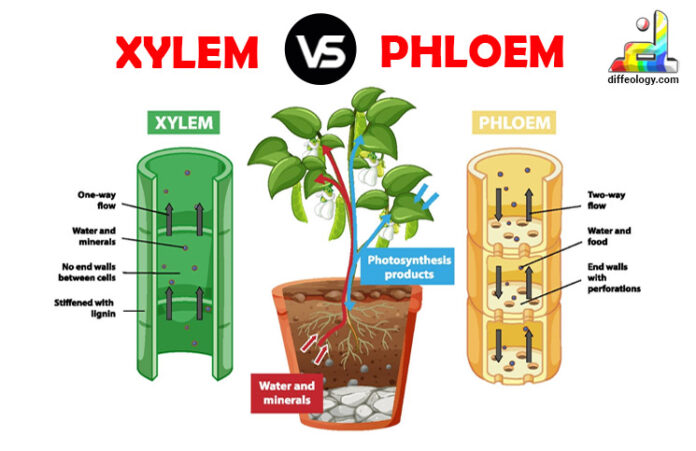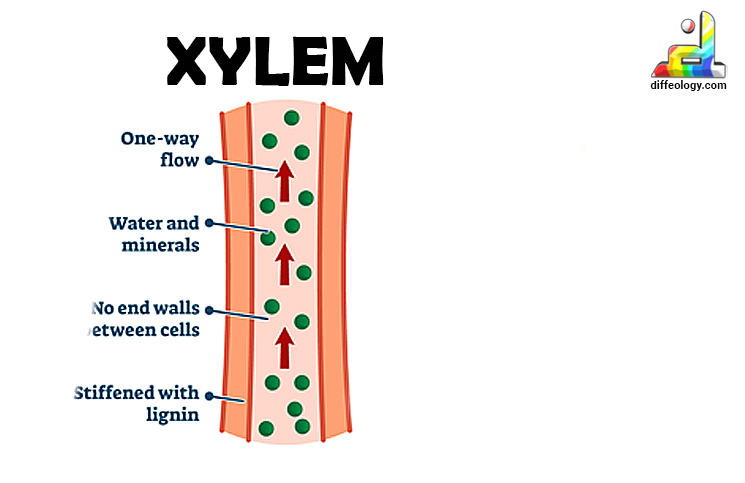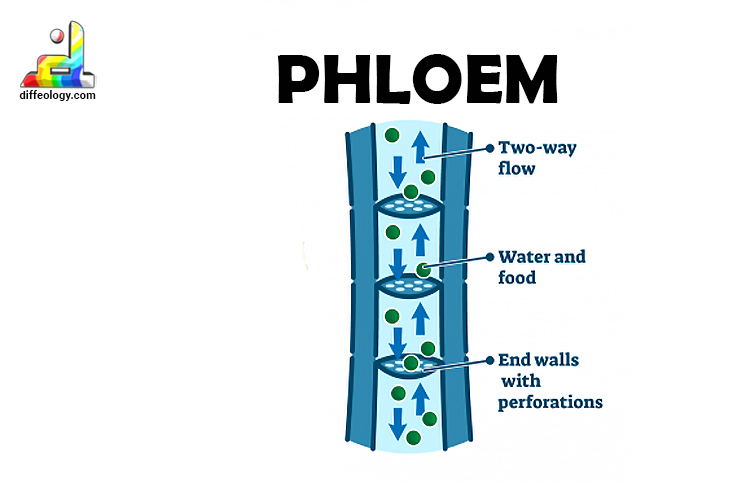Plants are incredible living beings, and just like us, they have their own systems for transporting essential materials throughout their bodies. Two key players in this process are xylem and phloem, which work together like a dynamic duo to keep plants healthy and growing strong. There is an obvious Difference between Xylem and Phloem.
Xylem acts like the water pipes in a house, carrying water and important minerals from the roots up to the leaves, while phloem operates as the delivery trucks, transporting sugars and other nutrients produced in the leaves to all parts of the plant. Understanding the differences between these two vital tissues not only gives us a glimpse into the inner workings of plants but also helps us appreciate the complexity and beauty of the natural world around us.
Main Difference Between Xylem and Phloem
Xylem and phloem are vascular tissues found in plants. They are responsible for the transportation of fluids and nutrients. While xylem primarily transports water and minerals from the roots to the rest of the plant, phloem transports sugars and other organic compounds produced during photosynthesis to various parts of the plant.
Xylem Vs. Phloem
What is Xylem?
Xylem is like the superhighway inside plants, but instead of cars, it carries water and important minerals from the ground up to all parts of the plant. Just like our bodies need water to stay hydrated and healthy, plants need water too, and xylem helps them get it. Imagine tiny tubes running from the roots all the way up to the leaves, kind of like pipes in a building. These tubes are made up of special cells called tracheids and vessel elements. They work together to form a strong structure that can withstand the pressure of carrying water upwards against gravity.
Read Also: Difference Between Plant and Animal cells
But xylem doesn’t just transport water; it also carries nutrients dissolved in the water, like a delivery service dropping off essential groceries to different parts of the plant. So, when you see a tall tree or a blooming flower, remember that it’s thanks to the hard work of xylem, making sure water and nutrients reach every leaf, stem, and flower petal, keeping the plant healthy and thriving.
What is Phloem?
Phloem is another important part of plants, but it’s like the highway for carrying food instead of water. Just like we need to eat to get energy, plants make their food through a process called photosynthesis in their leaves. The sugars produced during photosynthesis are transported to all parts of the plant through the phloem. So, if xylem is like the water pipes, phloem is like the delivery trucks bringing food to different parts of the plant.
Read Also: Difference Between Cytosol and Cytoplasm
Phloem is made up of living cells, unlike xylem, which is made of dead cells. These living cells, called sieve tubes and companion cells, work together to move the sugars and other nutrients around the plant. So, whenever you see a fruit growing on a tree or a flower blooming, it’s thanks to the hard work of phloem, making sure all parts of the plant get the energy they need to grow and thrive.
Comparison Table “Xylem Vs. Phloem”
| Structure | Made of dead cells forming tubes | Comprised of living cells arranged in tubes |
| Function | Transports water and minerals upwards | Transports sugars and nutrients bidirectionally |
| Location in Plant | Closer to center of stems and roots | Positioned towards outer regions |
| Components | Tracheids and vessel elements | Sieve tubes and companion cells |
| Direction of Flow | Moves water and nutrients upwards | Transports substances both up and down |
| Response to Damage | Can block damaged areas with tyloses | Lacks a similar mechanism for blocking |
| Transport Mechanism | Relies on capillary action and transpiration pull | Uses active translocation |
| Environmental Response | Adjusts to drought by reducing water loss | May alter sugar transport in response to light levels |
| Role in Plant Growth | Provides structural support | Fuels growth by transporting sugars to growing tissues |
| Interaction with Surrounding Cells | Cells lack cytoplasm, surrounded by support tissues | Connected to companion cells for metabolic support |
| Defense Mechanisms | Can clog to block pathogen spread | Relies on chemical defenses and signaling |
| Developmental Origin | Derives from procambium tissue | Originates from cambium tissue |
| Contribution to Plant Adaptation | Enables water transport, aiding in habitat adaptation | Supports resource allocation, helping plants thrive in changing environments |
Difference between Xylem and Phloem in Detail
Structure:
Xylem and phloem are two important tissues found in plants, but they have distinct structures. Imagine the plant as a highway system, where xylem acts like the pipes carrying water and minerals from the roots to the rest of the plant, while phloem acts like the lanes of a road, transporting sugars and other nutrients produced by the leaves to different parts of the plant.
Function:
The main job of xylem is to transport water and nutrients absorbed by the roots up to the leaves and other parts of the plant. It’s like a water elevator, pulling water from the soil and pushing it up through the plant.
On the other hand, phloem is responsible for carrying food produced during photosynthesis in the leaves to other parts of the plant, such as the roots, stems, and even fruits. It’s like a delivery truck, distributing the sugars made in the leaves to where they’re needed.
Direction of Flow:
Xylem and phloem also differ in the direction of their flow. Xylem moves water and nutrients upwards, against gravity, from the roots towards the shoots and leaves. Think of it like a water pump pulling water from the ground up through the plant.
Phloem, however, can transport nutrients both upwards and downwards, allowing for a bidirectional flow. It’s like a two-way street, with nutrients traveling both to and from different parts of the plant.
Components:
Xylem is primarily composed of specialized cells called tracheids and vessel elements, which are dead at maturity and form hollow tubes. These tubes provide structural support and efficient water transport.
In contrast, phloem consists of living cells, including sieve tubes and companion cells. These cells work together to transport sugars and other organic compounds throughout the plant.
Location:
In the plant’s vascular system, xylem and phloem are typically found together in vascular bundles, but they occupy different positions within these bundles. Xylem is usually located closer to the center of the stem or root, while phloem is positioned towards the outer region. This spatial arrangement reflects their respective roles in water and nutrient transport.
Composition:
Xylem and phloem also differ in their chemical composition. Xylem is primarily composed of lignin, a tough substance that provides structural support and helps prevent collapse of the xylem vessels. This lignified structure gives xylem its characteristic strength and durability.
Phloem, on the other hand, contains various organic compounds such as sugars, amino acids, and hormones, which are essential for plant growth and metabolism.
Response to Damage:
When a plant is injured or damaged, xylem and phloem respond differently to repair the damage. Xylem can undergo a process called tylose formation, where special outgrowths called tyloses block the xylem vessels to prevent the spread of pathogens and maintain water transport. Phloem, however, does not have a similar mechanism for blocking damaged areas. Instead, the plant relies on other defense mechanisms such as compartmentalization to isolate and contain the damage.
Understanding these differences between xylem and phloem helps us appreciate the amazing ways in which plants transport water, nutrients, and sugars to support their growth and survival.
Transported Substances:
Xylem and phloem transport different substances vital for a plant’s growth and survival. Xylem primarily carries water and minerals absorbed from the soil by the roots. It’s like the plant’s plumbing system, ensuring a constant flow of water and nutrients to all parts of the plant. Phloem, on the other hand, transports organic compounds such as sugars produced during photosynthesis in the leaves.
These sugars serve as energy sources and building blocks for various cellular processes, allowing the plant to grow and develop. So while xylem focuses on water and minerals, phloem focuses on sugars and other organic nutrients.
Transport Mechanism:
Xylem and phloem employ different mechanisms for transporting substances within the plant. Xylem relies on a combination of capillary action, cohesion, and transpiration pull to move water and minerals upwards from the roots to the leaves. It’s like a continuous flow driven by the plant’s need for water and the evaporation of water from the leaves.
Phloem, on the other hand, utilizes a process called translocation, where organic compounds are actively transported from sources (like leaves) to sinks (such as roots or developing fruits). This process requires energy and specialized cells to pump the sugars through the phloem tubes, ensuring a steady supply of nutrients to all parts of the plant.
Response to Environmental Conditions:
Xylem and phloem also respond differently to changes in environmental conditions. For example, during periods of drought or water scarcity, xylem may undergo adjustments to limit water loss and maintain hydration within the plant. This can include the closure of stomata to reduce transpiration and the production of special compounds to increase water retention.
Phloem, on the other hand, may adjust its rate of translocation in response to changing energy demands or resource availability. For instance, when sunlight is limited, photosynthesis decreases, leading to a reduction in sugar production and phloem transport.
Role in Plant Growth:
Xylem and phloem play distinct roles in supporting plant growth and development. Xylem provides structural support to the plant by forming a network of rigid tubes that help maintain the plant’s shape and stability. Additionally, the continuous flow of water and nutrients facilitated by xylem is essential for cell expansion and turgor pressure, which are necessary for growth.
Phloem, on the other hand, fuels growth by transporting sugars to actively growing tissues, where they are used as a source of energy for cellular processes and as building blocks for new cell growth. Without efficient phloem transport, plants would struggle to grow and reproduce.
Relationship with Surrounding Cells:
Xylem and phloem interact differently with surrounding cells and tissues within the plant. Xylem cells are dead at maturity and lack cytoplasm, allowing for the formation of continuous hollow tubes for water transport. These cells are closely associated with other support tissues such as fibers and sclerenchyma cells. They provide structural integrity to the plant.
In contrast, phloem cells remain alive and are connected to companion cells that provide metabolic support and help regulate phloem function. This close association allows for efficient nutrient transport and communication between different parts of the plant.
Role in Plant Defense:
Xylem and phloem also play different roles in defending the plant against pathogens and pests. Xylem vessels can become clogged with substances like resins or gums in response to infection or damage, effectively blocking the spread of pathogens throughout the plant. This physical barrier helps prevent further damage and infection, protecting the plant’s water transport system.
Phloem, on the other hand, lacks a similar mechanism for blocking pathogens. Instead, the plant relies on chemical defenses and systemic signaling to activate defense responses in other parts of the plant, limiting the spread of diseases and pests.
Developmental Origin:
Xylem and phloem originate from different types of plant tissues during development. Xylem is derived from the procambium, a meristematic tissue responsible for producing vascular tissues in the plant. As the plant grows, cells in the procambium differentiate into tracheary elements, which eventually form the xylem tissue.
Phloem, on the other hand, develops from the cambium, another meristematic tissue that produces secondary growth in plants. Cells in the cambium differentiate into sieve elements and companion cells, which together make up the phloem tissue. This difference in developmental origin contributes to the distinct structures and functions of xylem and phloem in mature plants.
Role in Plant Adaptation:
Xylem and phloem also contribute differently to a plant’s ability to adapt to its environment. Xylem allows plants to efficiently transport water and nutrients from the roots to the leaves, enabling them to survive in diverse habitats ranging from deserts to rainforests. Plants with specialized xylem adaptations, such as deep roots or narrow vessels, can better withstand drought or waterlogging.
Phloem, on the other hand, facilitates the distribution of sugars and other nutrients throughout the plant, supporting various metabolic processes and enabling plants to allocate resources effectively. This flexibility in resource allocation helps plants adapt to changing environmental conditions and optimize their growth and reproduction.
Key Points Showing the Difference Between Xylem and Phloem
- Transport Function: Xylem carries water and minerals from roots to leaves, while phloem transports sugars and other nutrients from leaves to the rest of the plant.
- Structural Composition: Xylem consists of dead cells forming tubes, whereas phloem comprises living cells arranged in tubes.
- Direction of Flow: Xylem moves water and nutrients upwards, but phloem can transport substances both up and down the plant.
- Location in Plant: Xylem is closer to the center of stems and roots, while phloem is positioned towards the outer regions.
- Components: Xylem is made up of tracheids and vessel elements, but phloem contains sieve tubes and companion cells.
- Response to Damage: Xylem can block damaged areas with tyloses, whereas phloem lacks a similar mechanism.
- Transported Substances: Xylem mainly carries water and minerals, while phloem transports sugars and other organic compounds.
- Transport Mechanism: Xylem relies on capillary action and transpiration pull, while phloem uses active translocation.
- Environmental Response: Xylem adjusts to drought by reducing water loss, while phloem may alter sugar transport in response to light levels.
- Role in Plant Growth: Xylem provides structural support, while phloem fuels growth by transporting sugars to growing tissues.
- Interaction with Surrounding Cells: Xylem cells are dead and lack cytoplasm, whereas phloem cells remain alive and are connected to companion cells.
- Defense Mechanisms: Xylem can clog to block pathogen spread, while phloem relies on chemical defenses and signaling.
- Developmental Origin: Xylem originates from procambium tissue, whereas phloem develops from cambium tissue.
- Contribution to Plant Adaptation: Xylem enables water transport, aiding plants in adapting to diverse habitats, while phloem supports resource allocation, helping plants thrive in changing environments.
FAQs: Xylem Vs. Phloem
Conclusion:
In the vast world of plants, the difference between Xylem and Phloem is simple. Xylem play indispensable roles, ensuring that water, nutrients, and sugars reach every part of the plant, from its deepest roots to its tallest leaves. While xylem moves water and minerals upwards against gravity, phloem transports sugars bidirectionally, fueling growth and providing energy for essential plant functions. Together, these two remarkable tissues form the backbone of the plant’s vascular system, enabling it to adapt to its environment, grow, and thrive.
References & External Links
- Xylem and Phloem Video – Transport in Plants



